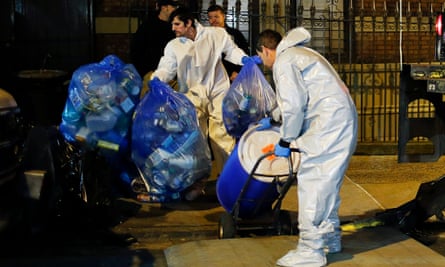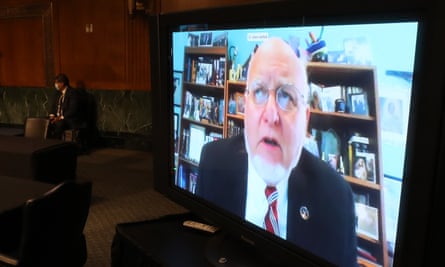Robert Redfield, the director of the Centers for Disease Control and Prevention (CDC), the world’s premier public health agency, was stooped over the White House lectern. He conceded that the coronavirus pandemic had “overwhelmed” the US, and that there would be a “difficult” second wave of the virus later in the year.
His boss had different thoughts, however. Redfield, a career virologist, made way for Donald Trump, the US president and former host of The Apprentice, who intoned to the cameras that Redfield had been “totally misquoted” in a previous Washington Post story warning of a damaging resurgence of Covid-19.
Invited to clarify, Redfield confirmed he was quoted correctly. Trump again took to the lectern to try a different tack. “You may not even have corona coming back,” the president said, contradicting Redfield again. “Just so you understand.”
The CDC director, looking on impassively, would not appear at a White House coronavirus press conference again.
The exchange, on 22 April, was seen by some CDC staff as grim confirmation that the agency’s venerated expertise has been shoved to one side as Covid-19 continues to ravage the US, causing more than 80,000 deaths so far.
For the first time since 1946, when the CDC flickered to life in a cramped Atlanta office with a brief to fight malaria, the agency is not at the frontline of a public health emergency in the US.
The low profile of the CDC has caused “frustration and some embarrassment”, according to Jeffrey Koplan, the director of the CDC under Bill Clinton and George W Bush. “It’s like you’re an accomplished violinist playing in a quartet and you’re told you can’t use your right arm. That’s the feeling.”
When facing previous threats to public health, from the H1N1 flu pandemic to salmonella outbreaks to the emergence of Severe Acute Respiratory Syndrome (Sars), the CDC was a hive of activity publicly and behind the scenes, holding daily briefings, working on vaccines, and crafting guidance solemnly followed by governments domestic and foreign.
But during Covid-19, the greatest health emergency in a century, the CDC has been almost entirely erased by the Trump administration as the public face of pandemic response. An approach of collaboration and open dialogue has been replaced by reticence and a fear of retribution from the Trump administration, according to some CDC staff.
The diminished role of the CDC is obvious to its former leaders. “There’s no question the CDC has been sidelined,” said Tom Frieden, CDC director during Barack Obama’s presidency.
“The US has not been making use of CDC’s expertise, and as a result the response has not been good as it could have been. I can only imagine how distressing it is to not contribute during to the biggest public health crisis in our lifetimes.”
Frieden said there is “puzzlement” among the American people over the CDC’s absence from the public stage, leading to confusion over the scope of the pandemic and the best measures to tackle it.

The early days of the virus outbreak did see several CDC officials issue stark warnings, only to disappear from public view. Nancy Messonnier, the director of the CDC’s National Center for Immunization and Respiratory Diseases, accurately forecast on 25 February that the virus was not contained and would grow into a pandemic.
This comment, which diverged from the confident assurances given by other administration officials, caused the stock market to plunge and prompted a reportedly enraged Trump to threaten to fire her.
Messonnier, one of the country’s most respected virus experts, was then removed from future White House press conferences and, after subsequently warning that the virus could extend into next year, has not featured since in public briefings held by the CDC.
“When we were hearing from Nancy regularly, we had a real sense of what was happening with the pandemic. But it clearly wasn’t popular with the administration,” said Frieden.
The White House’s coronavirus taskforce has taken on much of the CDC’s mantle. Redfield, currently self-quarantining after coming into contact with an administration adviser with Covid-19, is a member of the taskforce, but has been largely eclipsed by Anthony Fauci, the longtime director of the National Institute of Allergy and Infectious Diseases, who is also isolating himself for the same reason.
The presence of these experts has not prevented Trump making a string of inaccurate and potentially dangerous statements, such as claiming the virus would fade away by April, that a vaccine will be shortly available and that people may want to inject themselves with disinfectant to treat the virus.
“These weird therapies and concepts have undermined confidence,” said Koplan. “During a pandemic you’re not looking for weird, particularly from someone in ultimate authority.”

CDC advisories have either been fatally undermined or buried by the Trump administration or the president’s own pronouncements. After the CDC recommended the wearing of face coverings in public, Trump used the same announcement to confirm he would not, in fact, be wearing a mask.
“Somehow sitting in the Oval Office behind that beautiful Resolute Desk, the great Resolute Desk, I think wearing a face mask as I greet presidents, dictators, kings, queens, I don’t know, I don’t see it for myself,” the president said. Frieden said the garbled message conveyed to the public was “very unfortunate”.
Other advice sent from the CDC’s Atlanta base to the White House has been rejected, such as a suggestion in March that sick and elderly Americans be advised not to fly on commercial airlines because of Covid-19. A CDC stipulation that cruise ships remain docked until August was amended by the White House to allow the ships to set sail a month earlier.
As Trump shifted from fraught attempts to contain the coronavirus to advocate for a reopening of American businesses, the CDC drew up a step-by-step guide, approved by Redfield, for state and local authorities on how to safely allow people to frequent restaurants, bars and other public spaces again.
However, the White House told scientists the guidance would “never see the light of day”, according to reporting by AP. Trump advisers, including the president’s chief of staff, Mark Meadows, reportedly felt the document was too prescriptive. The CDC put forward much stricter advice on reopenings than the White House, according to AP, such as placing a much longer timeframe before non-essential travel was recommended to resume.
The decision has left the US with no detailed federal plan on how to emerge from the pandemic lockdown, echoing the administration’s lack of a plan to roll out widespread testing and contact tracing to try to curb the spread of the virus. At one point, Trump claimed to have ultimate authority over such matters but has since left it to individual states on how to proceed.
“There continues to be absent a cohesive, thoughtful plan that everyone can buy into and follow,” said Koplan. “Leaving it to the states alone is somewhat misguided. There is no federal game plan, and there is a price to pay for that.”

The CDC has also erred during the pandemic, most significantly in the initial effort to develop its own test for Covid-19. The testing kits proved to be faulty, with the problem compounded by sluggish efforts to rectify the deficiencies and then by severe bottlenecks in distributing enough tests to the public. The US is still falling well short of the number of tests experts say is needed every day to allow a safe resumption of normal life.
But public health specialists are still mystified by the CDC’s low profile as the pandemic has swept across the country.
“The CDC has the best public health officials there are – they are very intelligent and tremendous public servants. But they have been sidelined,” said Howard Koh, former assistant secretary for health. “We need their scientific leadership right now.”
Koplan said the last few months has left the CDC “badly bruised” but added it was encouraging that polling shows Americans still mostly have positive feelings about the agency. “The CDC has been shaken but this experience will show that we need to reaffirm its role,” he said.
A spokesman for the CDC said there was no ban or restriction on agency experts speaking publicly.
“The mainstays of CDC – epidemiology, laboratory science and surveillance – are helping shape our nation’s response, as well as the response by our state and local health department partners who continue to be on the frontline fighting this war,” he said.
“CDC is 100% engaged operationalizing the response throughout this nation.”
